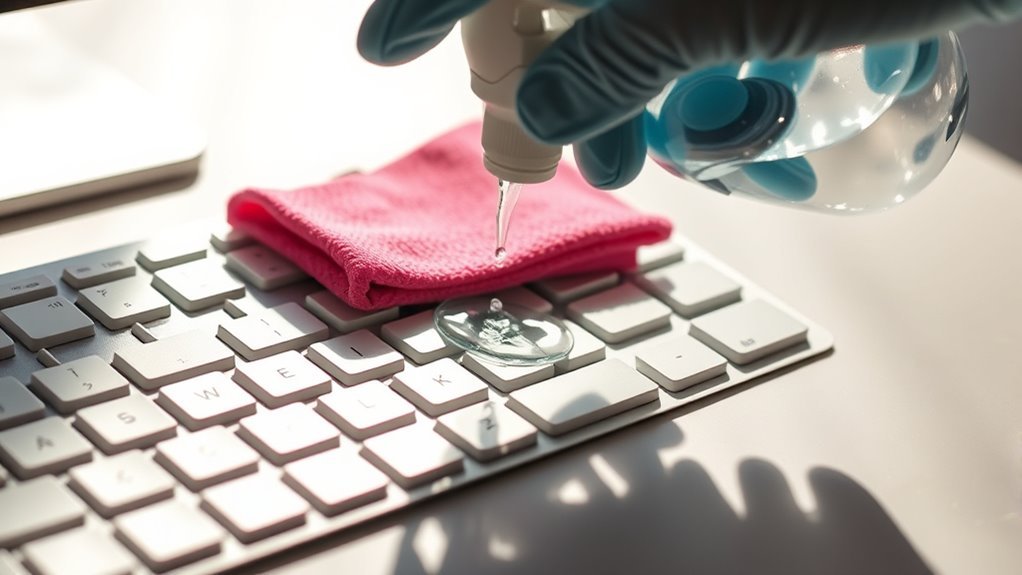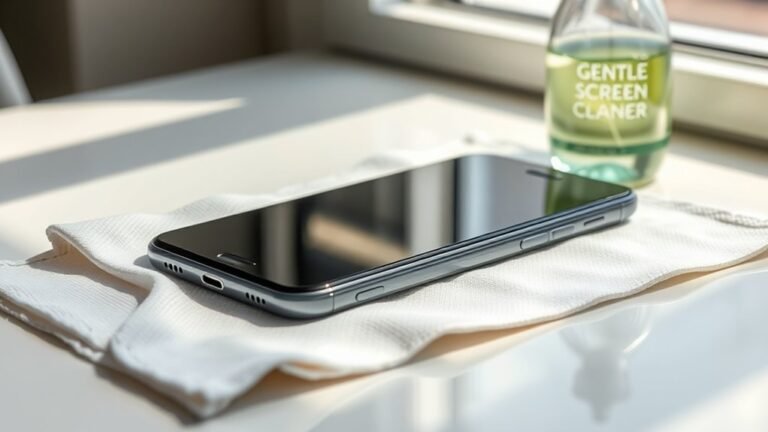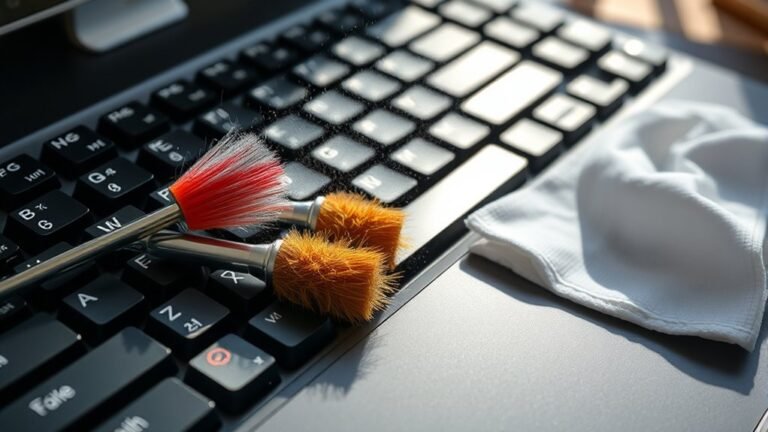Disinfecting High-Touch Areas in Keyboard
You touch your keyboard constantly, especially keys like the spacebar and Enter, which can harbor bacteria such as Staphylococcus and E. coli. To disinfect, first unplug or power off your device. Use a microfiber cloth lightly dampened with an electronics-safe disinfectant, wiping high-touch areas gently while avoiding moisture buildup. Regular cleaning prevents germ buildup but don’t overdo it to protect key labels. Keep your workspace clean, and you’ll find tips to maintain your keyboard’s hygiene and durability.
Understanding High-Touch Areas on Keyboards

High-touch areas on keyboards are the spots you interact with most frequently, like the spacebar, enter key, and frequently used letters. Your user habits shape which keys get the most wear and contact, influencing where germs might concentrate. Keyboard design plays a role too—some layouts cluster common keys, while others spread them out, affecting your natural touch points. When you think about your keyboard, consider how your typing style and shortcuts impact these areas. By understanding this, you gain control over how to keep your keyboard clean without sacrificing freedom or comfort. Recognizing the patterns in your keyboard use empowers you to focus your attention where it matters most, maintaining a workspace that supports your independence and ease.
Risks of Germs and Bacteria on Keyboards
You might not realize it, but your keyboard has germ hotspots where bacteria like Staphylococcus and E. coli can thrive. These common microbes can easily transfer to your hands and increase your risk of illness. Understanding these health risks is key to keeping your workspace safe and clean.
Germ Hotspots on Keyboards
Keyboards often harbor more germs than you might expect, making them prime spots for bacteria to thrive. The areas you touch most—like the spacebar, Enter key, and arrow keys—are especially vulnerable. These high-contact zones accumulate oils, sweat, and crumbs, creating a breeding ground for germs. If you want to maintain good keyboard hygiene and support effective germ prevention, focusing your cleaning efforts on these hotspots is essential. Don’t forget the edges and between keys, where dirt and microbes often hide unnoticed. By regularly disinfecting these critical areas, you reduce the risk of contamination and keep your workspace healthier. Taking control of your keyboard’s cleanliness means reclaiming freedom from unseen threats that might otherwise slow you down.
Common Keyboard Bacteria
Although it might not be obvious, the surfaces you use daily can harbor a surprising variety of bacteria. Your keyboard is no exception. Common pathogens like Staphylococcus aureus, E. coli, and even Candida species often settle on keys, especially where your fingers frequently rest. These microbes thrive in the tiny crevices between keys, making keyboard hygiene essential. Without regular cleaning, these pathogens multiply, increasing your exposure to germs. Maintaining good keyboard hygiene isn’t just about cleanliness—it’s about reclaiming control over your personal space and health. By regularly disinfecting your keyboard, you reduce the risk of these common pathogens lingering and spreading. Taking a few minutes to clean your keyboard can empower you to create a safer, more hygienic environment where you work or play freely.
Health Risks From Contamination
Several types of harmful bacteria and germs lurking on your keyboard can lead to health issues if not addressed. Ignoring surface sanitation increases the risk of these microbes spreading and causing problems. Understanding the health implications motivates you to keep your workspace clean and safe. Here are key risks to take into account:
- Infections – Bacteria like E. coli and Staphylococcus can cause skin and respiratory infections.
- Allergic Reactions – Dust and mold on keyboards can trigger allergies and asthma.
- Gastrointestinal Issues – Germs transferred from hands to mouth can lead to stomach illnesses.
- Cross-Contamination – Sharing keyboards without cleaning promotes the spread of viruses and bacteria.
Recommended Cleaning Materials and Tools
When you’re ready to disinfect your keyboard, having the right cleaning materials and tools makes the process faster and more effective. You’ll want to use disinfectant wipes for quick, no-fuss cleaning—just grab one and wipe down the keys and surfaces. For a deeper clean, cleaning sprays designed for electronics are your best bet; they guarantee you don’t damage your keyboard while removing stubborn grime. Pair these with a microfiber cloth to gently lift dirt without scratching. Avoid using harsh chemicals or abrasive materials that could harm your device. With these essentials, you gain the freedom to keep your workspace healthy and your keyboard spotless without hassle or risk. Simple, efficient tools let you maintain cleanliness on your terms—no compromises needed.
Step-by-Step Guide to Disinfecting Your Keyboard

Disinfecting your keyboard involves a few simple steps that guarantee every key and surface is thoroughly cleaned without causing damage. Embracing proper keyboard maintenance lets you enjoy a clean, germ-free workspace while preserving your device’s lifespan. Follow these practical disinfecting techniques:
- Unplug your keyboard or turn off your laptop to avoid accidental inputs.
- Use a soft, lint-free cloth lightly dampened with a disinfectant solution suited for electronics.
- Gently wipe all high-touch areas, including keys and surrounding surfaces, ensuring no moisture seeps inside.
- Allow your keyboard to air dry completely before reconnecting or powering on.
Tips for Cleaning Between and Under Keys
When cleaning between and under keys, you’ll want to use safe tools like soft brushes or compressed air to avoid damage. Gently removing debris can keep your keyboard functioning smoothly without risking harm. Let’s look at the best techniques to get those hard-to-reach spots spotless.
Safe Cleaning Tools
Cleaning between and under your keyboard keys can be tricky, but using the right tools makes the job much easier and safer. To keep your keyboard spotless without damaging it, you’ll want to equip yourself with the best cleaning essentials. Here’s what you should use:
- Microfiber cloths – gentle and effective for wiping surfaces without scratching.
- Alcohol wipes – perfect for disinfecting high-touch areas, killing germs quickly.
- Soft-bristled brushes – ideal for reaching tight spaces without harming key mechanisms.
- Compressed air cans – great for blowing out dust and debris from hard-to-reach spots.
Using these safe tools guarantees thorough cleaning while protecting your keyboard’s delicate parts. With the right gear, you’re free to maintain a clean, germ-free workspace effortlessly.
Removing Debris Techniques
Although it might seem tedious, removing debris from between and under your keys is essential to keep your keyboard functioning smoothly. Start with simple debris removal by turning your keyboard upside down and gently shaking it to dislodge loose particles. You can also use compressed air to blow out stubborn crumbs from hard-to-reach spots. For deeper cleaning methods, carefully remove keycaps if your keyboard allows it, then use a soft brush or microfiber cloth to clear away dirt underneath. Remember to avoid harsh tools that might damage the keys or mechanisms. Staying consistent with these debris removal techniques guarantees your keyboard stays responsive and hygienic, giving you the freedom to work or play without interruptions. Simple, effective cleaning methods go a long way in preserving your device’s lifespan.
How Often Should You Disinfect Your Keyboard?

How often should you disinfect your keyboard to keep it safe and hygienic? Following clear frequency guidelines helps you maintain freedom from germs without hassle. Your cleaning schedules should match how often you use the keyboard and the environment it’s in. Here’s a simple numeric list to guide you:
- Daily: If you share your keyboard or eat at your desk, wipe down high-touch areas every day.
- Weekly: For solo users in clean spaces, a weekly disinfection is usually enough.
- Monthly: Light users or infrequent keyboard usage calls for monthly cleaning.
- After Illness: Always disinfect immediately if you or someone nearby has been sick.
Stick to these frequency guidelines, and your keyboard stays fresh without chaining you to constant cleaning.
Precautions to Avoid Damaging Your Keyboard
Taking a few simple precautions can save your keyboard from accidental damage during disinfection. First, always check the keyboard materials before choosing cleaning products—some plastics and coatings react poorly to harsh chemicals or excessive moisture. Avoid spraying liquids directly onto the keyboard; instead, dampen a cloth lightly to prevent seepage underneath the keys. Keep your cleaning frequency balanced; over-cleaning can wear down key labels or degrade materials, while under-cleaning invites grime buildup. Use gentle, non-abrasive wipes designed for electronics and steer clear of bleach or ammonia-based solutions. By respecting your keyboard’s build and adjusting your cleaning routine thoughtfully, you’ll keep it functional and fresh without risking costly damage. Freedom to clean safely means understanding these limits and acting accordingly.
Best Practices for Maintaining a Hygienic Workspace
When you maintain a hygienic workspace, you not only protect yourself from germs but also create a more productive environment. Keeping your area clean supports your freedom to focus and work comfortably. Here are some best practices to achieve this:
- Regularly disinfect high-touch areas like your keyboard and mouse to minimize bacteria buildup.
- Keep workspace organization in check by decluttering daily—this reduces dust and stress.
- Verify your ergonomic setup is clean and properly adjusted to prevent strain and promote comfort.
- Wash your hands before and after using shared equipment to avoid cross-contamination.
Frequently Asked Questions
Can Disinfecting Keyboards Affect Their Warranty?
You might wonder if disinfecting keyboards affects your warranty. It really depends on the warranty policies of your device’s manufacturer. Some are strict about cleaning methods, especially if liquids or harsh chemicals are involved. To keep your freedom to clean without risking coverage, check those policies carefully. Using approved cleaning methods guarantees you won’t void your warranty while maintaining your keyboard’s hygiene and functionality.
Are UV Light Sanitizers Effective for Keyboards?
Did you know UV light can kill up to 99.9% of germs? When it comes to keyboards, UV light sanitizers offer impressive sanitizing efficiency without the hassle of liquids or wipes. You get a quick, chemical-free way to keep your workspace germ-free, letting you stay focused and free to work wherever you want. Just remember to follow the device instructions so you get the best results without damaging your gear.
How to Disinfect Mechanical Keyboards Differently?
When you’re cleaning mechanical keyboards, you’ve got to treat those mechanical keycaps with care. Unlike regular keyboards, you can remove the keycaps for a deep clean. Use gentle cleaning techniques like soaking keycaps in soapy water and wiping the board with isopropyl alcohol. This way, you get freedom from grime without damaging delicate switches. Just remember to let everything dry completely before reassembling, and you’re good to go!
Can Keyboard Covers Reduce the Need for Cleaning?
You’d think keyboard covers could save you from a lifetime of endless cleaning, right? While they do help reduce dust, crumbs, and spills, they don’t eliminate the need for keyboard maintenance entirely. The effectiveness depends on cover materials—silicone or TPU covers shield better but can trap grime underneath. Using a cover gives you more freedom from frequent deep cleans, but you’ll still want to disinfect occasionally to keep germs at bay and your keyboard fresh.
Is Alcohol Safe for Backlit Keyboard Keys?
When it comes to keyboard maintenance, you might wonder if alcohol is safe for backlit keys. Generally, isopropyl alcohol is fine in small amounts, but you’ll want to avoid harsh cleaning solutions that could damage the lighting or key coatings. Use a lightly dampened cloth instead of soaking the keys. This way, you keep your keyboard clean without risking the backlight, giving you freedom to enjoy your device worry-free.






